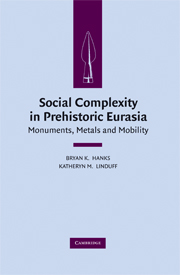Book contents
- Frontmatter
- Contents
- Contributors
- Foreword: From Myth to Method: Advances in the Archaeology of the Eurasian Steppe
- CHAPTER 1 Introduction: Reconsidering Steppe Social Complexity within World Prehistory
- PART ONE FRAMING COMPLEXITY
- PART TWO MINING, METALLURGY, AND TRADE
- PART THREE FRONTIERS AND BORDER DYNAMICS
- PART FOUR SOCIAL POWER, MONUMENTALITY, AND MOBILITY
- Index
Foreword: From Myth to Method: Advances in the Archaeology of the Eurasian Steppe
Published online by Cambridge University Press: 26 January 2010
- Frontmatter
- Contents
- Contributors
- Foreword: From Myth to Method: Advances in the Archaeology of the Eurasian Steppe
- CHAPTER 1 Introduction: Reconsidering Steppe Social Complexity within World Prehistory
- PART ONE FRAMING COMPLEXITY
- PART TWO MINING, METALLURGY, AND TRADE
- PART THREE FRONTIERS AND BORDER DYNAMICS
- PART FOUR SOCIAL POWER, MONUMENTALITY, AND MOBILITY
- Index
Summary
In recent years, the archaeology of the Eurasian steppe has seen some remarkable advances. Up to a couple of decades ago, it seemed that little progress was being made, despite important archaeological discoveries in a number of relevant countries. The same rather simple models, based on an undifferentiated view of mobile steppe pastoralism and the notion of a short yet significant episode in which the domestication of the horse was achieved, had held sway since the early twentieth century. The valid contrasts emphasized in The Steppe and the Sown by Peake and Fleure (1928) led in the early work of Gordon Childe (1926) to a simplistic view of mounted nomad pastoralists, a view that has survived into recent times, although it was later reassessed by Childe himself (1950).
Today the picture is completely transformed, as the present volume emphasizes. In particular, recent discoveries have now allowed a clear differentiation to be established between the developments of the Bronze and Iron Ages in the steppes, in social and economic terms as much as in metallurgy. The development toward a pastoralist economy in the earlier Bronze Age, as well exemplified by the Sintashta culture of western Siberia with its chariot burials (Koryakova and Epimakhov 2007 : 66–80; Parzinger 2006 : 251–259, 338–342), was not accompanied by any conspicuous evidence of horse riding for military purposes, although horses are documented for drawing chariots as early as 2000 bce and were presumably ridden earlier than this for the purposes of herding (see Renfrew 1998).
- Type
- Chapter
- Information
- Social Complexity in Prehistoric EurasiaMonuments, Metals and Mobility, pp. xv - xxPublisher: Cambridge University PressPrint publication year: 2009
- 1
- Cited by

